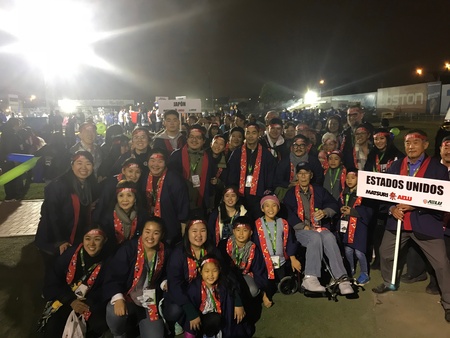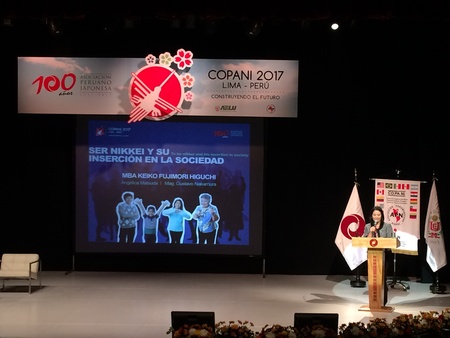Held every two years since 1981, COPANI (Convención Panamericana Nikkei, or Pan-American Nikkei Convention) is a conference where North, Central, and South American Nikkei (people of Japanese descent) gather. The 19th COPANI took place in Lima, Peru, November 2–5, 2017. Delegates from 14 countries including Japan—each represented by their own APN (Asociación Panamericana Nikkei) or PANA (Pan-American Nikkei Association)—participated.
My friend Lesli, with whom I traveled to attend this conference, had told me about it months earlier, after she heard about it from an active participant. It sounded interesting, but we didn’t decide to go until the last minute. However, we are so glad we went. Here’s why: It’s because we got to meet a lot of people from various countries with whom we share one thing in common: our Japanese heritage. We got to interact with Japanese Peruvians, Japanese Mexicans, Japanese Chileans, Japanese Brazilians, Japanese Paraguayans, Japanese Argentinians, Japanese Dominicans, and others, including fellow Japanese Americans and even Japanese nationals.
Most events took place inside the Centro Cultural Peruano Japonés (Japanese Peruvian Cultural Center), where the APJ (Asociación Peruano Japonesa, or Japanese Peruvian Association) is housed, and its grand theater, Teatro Peruano Japonés. The center is also home to the Museo de la Inmigración Japonesa al Perú "Carlos Chiyoteru Hiraoka" (Museum of Japanese Immigration to Peru), which has interesting historical and cultural artifacts.
I must say that I enjoyed everything, except for the fact that I had some kind of food poisoning or other illness for most of the trip. I suspect it was the Pisco Sour drink I had the night of the grand 100th anniversary celebration of the APJ held at the AELU (Asociación Estadio La Unión, a sports club facility) in conjunction with COPANI 2017, but I’ll never know what the cause of it was. It was terrible, and I couldn’t fully enjoy everything, but I have no regrets going on this trip, because it was an amazing experience overall. I’m grateful to the trilingual simultaneous interpreter I happened to meet, who helped me get checked by a nurse at the Tópico, a small medical room inside the center, and get what I needed at the Policlínico Peruano Japonés (Japanese Peruvian Polyclinic), which provides affordable medical care to Peruvians.
On the first night, we were warmly welcomed to Peru at the residence of the Ambassador of Japan. On the third night, at the huge Matsuri AELU 2017 festival, we marched in as delegates from the US, which felt like a mini Olympics Opening Ceremony. We saw the many organizations represented, such as the kenjinkai groups, and there were even some mikoshi circling around.There were also performances by artists from various countries at these events and at the Festival Artístico Internacional (International Arts Festival) before the closing ceremony, which was an amazing international experience. We got to enjoy traditional and modern Peruvian musical performances throughout these events and at the COPANI Sayonara Party as well, where we danced along with the Latinoamericano vibe. Dancing like that is something I lost while living in Japan, where such opportunities are scarce unless you go clubbing. Even though I wasn’t feeling too well, I still had fun.
The conference itinerary included a city tour of Lima on the final day, where the highlight was visiting Museo Convento San Francisco y Catacumbas (Museum of the San Francisco Convent and Catacombs). Peru is a Catholic nation for the most part, and this is where over 40,000 people's bones are buried! It was quite an eerie experience seeing displays of so many skulls and femur bones. As someone from San Francisco, it was cool to visit another San Francisco, even though this one is a monastery, not a city. After COPANI was over, we went on a tour of Cusco (or Cuzco) and Machu Picchu, which was fascinating. It was also nice to see some of our fellow COPANI participants again!
Identity, Language, and Culture
I knew that the largest population of Nikkeijin in the world is in South America, and as a Japanese American who has struggled with her identity, I was always interested in meeting some of them. I was curious to find out about the differences and similarities between them and me/us. It was great meeting lots of people who are like me, yet not quite like me. Other than two Japanese Paraguayans and one Japanese Argentinian I already knew from years before, this was my first time meeting Latin American Nikkei.
Here in the US, it’s rare to see people of Japanese descent speaking Spanish or Portuguese fluently, but I know it’s nothing out of the ordinary. As Nikkeijin, we speak the language of our adopted countries, so of course they speak Spanish or Portuguese, just like I speak English. But being in Peru, in South America, and in a Latin American Spanish-speaking country all for the first time, was a very special experience for me and my friend Lesli. We both studied Spanish in high school and college, but forgot most of what we had learned, so being in such an environment was an eye-opening experience for us. Our limited Spanish slowly started coming back during the trip, and I returned home motivated to relearn it.
I would've gotten much more out of the COPANI conference lectures and workshop had my Spanish been better. Simultaneous interpreting was provided during the lectures, but not for the workshop that Lesli and I attended. It was completely in Spanish so we struggled to understand and therefore couldn’t participate or ask questions for fear of repeating others’ questions and comments. It made me wish I had continued studying Spanish, but then again, I was focusing more on my Japanese. I wanted to live and work in Japan someday (which I did for several years until this past spring), and to me, my parents’ mother tongue was more important.
I am bilingual in English and Japanese, and at COPANI, I met people who speak both of these languages. However, I feel like my two languages aren’t enough. My new goal is to be able to understand more and communicate well en Español by the next COPANI, which is happening right here in my hometown of San Francisco in 2019. Although it’s going to be a lot of work preparing for such a big event, I’m excited to reunite with my new friends (whom I already miss) and welcome them and others. It will be a great opportunity to introduce them to what this city has to offer, and share the Japanese American experience with them. It would also be nice to visit more countries I haven't been to yet, so I look forward to future COPANIs as well.

Besides language, another difference among Nikkeijin is culture. We all share Japanese traditions, but we also participate in the culture of our adopted countries. For example, a funny and immediate thing I had to get accustomed to was the greeting with a kiss on the cheek. Even when we met for the first time, I felt like I had to try to greet back the same way the other person did. After all, when in Latin America, do what the Latinoamericanos do! Although I have encountered and respect this very friendly custom, I'm still not accustomed to it. It's probably because I didn't grow up with it, and I also lived in Japan for several years, where it's nonexistent. So if my kisses on the cheek were weak, it's not because I didn’t like the person, I was just poor at it—embarrassingly so. I'm much better at just hugging, giving handshakes, and bowing.
I also had a hard time remembering to not flush any toilet paper down the toilet. The sewage system there isn’t as fully developed as it is in the US and Japan. Also, there are some wild drivers in Peru. Riding in the COPANI bus and in our new friend’s car were fine, but the Uber and taxi drivers we had drove pretty roughly. Even as pedestrians, it was hard to cross the street at times. Apparently, they’re working to improve traffic law enforcement.
Language and culture are the largest components of one’s identity, and they are shaped by the environments and societies in which we live. Another observation I had was that just like in the US, depending on the generation, there are Nikkei who can and cannot speak Japanese. However, many Nikkeijin of any generation are proud and appreciative of their Japanese heritage. It is because of our ancestors that we are able to survive with rights as citizens in our respective countries, and have access to our roots.
The theme of this year’s COPANI was “Construyendo el futuro,” which means “Building the future.” As Nikkei, it is important to improve current situations for a better future, by learning about each other’s communities and exchanging ideas. We got to learn more about the modern Latin American Nikkei experience in countries such as Peru directly from Japanese Peruvians themselves (including Peru's ex-President Alberto Fujimori's daughter, Keiko, who touched upon the “model minority myth” without actually saying this term) as well as others, and what they can do in the future.
Although this trip was too short, it was the perfect opportunity for me to meet many other Nikkeijin and visit Machu Picchu. I feel like my worldview has expanded a little further. I’m thankful for the new friendships and connections I’ve gained, and I hope to continue to be one of the many active members of the global Nikkei community. I highly recommend taking part in future COPANI conferences. Please feel free to comment below if you are interested in getting involved. For more information about COPANI 2017, please visit copanilima.com.
© 2017 Asuka Nagase







